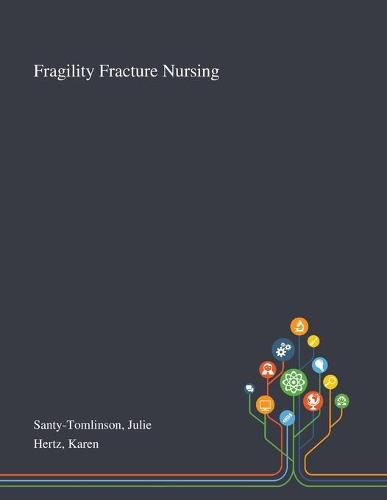Readings Newsletter
Become a Readings Member to make your shopping experience even easier.
Sign in or sign up for free!
You’re not far away from qualifying for FREE standard shipping within Australia
You’ve qualified for FREE standard shipping within Australia
The cart is loading…






This title is printed to order. This book may have been self-published. If so, we cannot guarantee the quality of the content. In the main most books will have gone through the editing process however some may not. We therefore suggest that you be aware of this before ordering this book. If in doubt check either the author or publisher’s details as we are unable to accept any returns unless they are faulty. Please contact us if you have any questions.
This open access book aims to provide a comprehensive but practical overview of the knowledge required for the assessment and management of the older adult with or at risk of fragility fracture. It considers this from the perspectives of all of the settings in which this group of patients receive nursing care. Globally, a fragility fracture is estimated to occur every 3 seconds. This amounts to 25 000 fractures per day or 9 million per year. The financial costs are reported to be: 32 billion EUR per year in Europe and 20 billon USD in the United States. As the population of China ages, the cost of hip fracture care there is likely to reach 1.25 billion USD by 2020 and 265 billion by 2050 (International Osteoporosis Foundation 2016). Consequently, the need for nursing for patients with fragility fracture across the world is immense. Fragility fracture is one of the foremost challenges for health care providers, and the impact of each one of those expected 9 million hip fractures is significant pain, disability, reduced quality of life, loss of independence and decreased life expectancy. There is a need for coordinated, multi-disciplinary models of care for secondary fracture prevention based on the increasing evidence that such models make a difference. There is also a need to promote and facilitate high quality, evidence-based effective care to those who suffer a fragility fracture with a focus on the best outcomes for recovery, rehabilitation and secondary prevention of further fracture. The care community has to understand better the experience of fragility fracture from the perspective of the patient so that direct improvements in care can be based on the perspectives of the users. This book supports these needs by providing a comprehensive approach to nursing practice in fragility fracture care.; Provides a comprehensive discussion of nursing the frail older person with a fragility fracture across Europe Based on a two-day workshop of like-minded specialist and advanced nurses from over 20 countries Acts as the course text/reader for a Europe-wide education programme in all relevant settings (Emergency Department, Fracture Clinic, Trauma Unit, Orthopaedic Ward, Rehabilitation setting) Open Access This work was published by Saint Philip Street Press pursuant to a Creative Commons license permitting commercial use. All rights not granted by the work’s license are retained by the author or authors.
$9.00 standard shipping within Australia
FREE standard shipping within Australia for orders over $100.00
Express & International shipping calculated at checkout
This title is printed to order. This book may have been self-published. If so, we cannot guarantee the quality of the content. In the main most books will have gone through the editing process however some may not. We therefore suggest that you be aware of this before ordering this book. If in doubt check either the author or publisher’s details as we are unable to accept any returns unless they are faulty. Please contact us if you have any questions.
This open access book aims to provide a comprehensive but practical overview of the knowledge required for the assessment and management of the older adult with or at risk of fragility fracture. It considers this from the perspectives of all of the settings in which this group of patients receive nursing care. Globally, a fragility fracture is estimated to occur every 3 seconds. This amounts to 25 000 fractures per day or 9 million per year. The financial costs are reported to be: 32 billion EUR per year in Europe and 20 billon USD in the United States. As the population of China ages, the cost of hip fracture care there is likely to reach 1.25 billion USD by 2020 and 265 billion by 2050 (International Osteoporosis Foundation 2016). Consequently, the need for nursing for patients with fragility fracture across the world is immense. Fragility fracture is one of the foremost challenges for health care providers, and the impact of each one of those expected 9 million hip fractures is significant pain, disability, reduced quality of life, loss of independence and decreased life expectancy. There is a need for coordinated, multi-disciplinary models of care for secondary fracture prevention based on the increasing evidence that such models make a difference. There is also a need to promote and facilitate high quality, evidence-based effective care to those who suffer a fragility fracture with a focus on the best outcomes for recovery, rehabilitation and secondary prevention of further fracture. The care community has to understand better the experience of fragility fracture from the perspective of the patient so that direct improvements in care can be based on the perspectives of the users. This book supports these needs by providing a comprehensive approach to nursing practice in fragility fracture care.; Provides a comprehensive discussion of nursing the frail older person with a fragility fracture across Europe Based on a two-day workshop of like-minded specialist and advanced nurses from over 20 countries Acts as the course text/reader for a Europe-wide education programme in all relevant settings (Emergency Department, Fracture Clinic, Trauma Unit, Orthopaedic Ward, Rehabilitation setting) Open Access This work was published by Saint Philip Street Press pursuant to a Creative Commons license permitting commercial use. All rights not granted by the work’s license are retained by the author or authors.